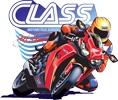Safety, skill & speed go hand-in-hand at Reg Pridmore’s CLASS Motorcycle School
By Aaron Frank
If the Motorcycle Safety Foundation’s RiderCourse and Experienced RiderCourse are considered the primary and secondary schools of motorcycle riding, think of Reg Pridmore’s CLASS Motorcycle Schools as a graduate-level education. Where the MSF courses do an excellent job of introducing and reinforcing the core concepts- effective braking, shifting and cornering- and teaches riders how to confidently employ them in a real-time environment- at speed on the racetrack.
Though his classes take place on a racetrack, Pridmore’s courses are not intended for racers. “It’s not a race school,” says Pridmore. “I teach control. I think that nine-tenths of riders aren’t really in control of their bikes- they operate at various levels of a lack of control most of the time. I try to teach them to control their bikes in a safe environment on the racetrack, so they can adapt the techniques to feel more confident and in control on the street.”
Indeed, it was originally concern for the safety of street riders that got Pridmore, a three-time AMA Superbike Champion (1976-78) and former BMW dealer, teaching safety in the first place. “Back in the early seventies, when the [Kawasaki] Z-1 came out, it was killing a lot of young kids and it made me really mad,” says Pridmore. “We were always hearing about fatalities, and it wasn’t just kids who didn’t have enough sense to know what to do with the throttle. It was giving motorcycling a bad name.”
Pridmore taught his first private safety school to a riding club in Denver in 1974, and formally established CLASS (which, incidentally, is an acronym for California’s Leading Advanced Safety School) in 1986. Now entering its 16th season, Pridmore and his diverse team of instructors and assistants lead well over 50 sessions a year at track all around the country.
Though it isn’t intended for beginners, CLASS hosts just about every other sort of rider- from newbies in their first year on the bike to seasoned club racers riding everything form cutting-edge sportbikes to fully loaded tourers. CLASS’s only requirement is that the rider be comfortable at freeway speeds and completely familiar with the motorcycle’s controls and operation. Pridmore says he also sees a fair amount of re-entry riders passing through his doors. Like dealers are finding, these “weekend warriors,” sometimes present the biggest challenges. “I really feel sad for the guys with all the money, who see their neighbor’s bike and have to go out and get something bigger and better,” says Pridmore. “The big, hairy bikes we’ve got today are way beyond what many of these people can handle. If they’re not fully aware, they start getting carried away and do some bad things. In these cases, we try to humble them a bit.”
If the session that we attended at Michigan’s Grattan Raceway is any indication, CLASS schools are refreshingly low-key and non-threatening. Less dogmatic than some other offerings, Pridmore prefers to present his students with a range of possible techniques and then allow them to experiment, trying out different riding styles until the find the methods that make them the most comfortable.
“It’s a very relaxed atmosphere,” says Pridmore. “I think people should be left to their own decisions about what does and doesn’t work for them. I’m not really interested in telling people what to do, or baffling them with a bunch of technical BS. I leave it very open and ask people to come to it with a wide-open mind, so that they can figure out what works for them. If it does work, use it; if it doesn’t work, fine, park it.”
As an example, Pridmore takes a moderate position on the countersteering debate that perpetually dogs riding-technique discussions. “Bodysteering versus countersteering: It’s not a matter of one over the other. It’s a matter of works in a given situation,” notes Pridmore. “I use both of them at different times, depending on the situation. I think that my students should have both options available to them so that they can choose.”
Students certainly appreciate the open format of CLASS. “My one-on-one discussions with the instructors have been extremely helpful,” says Jason Water, a sportbike rider who traveled from northern Indiana to attend the school. “I totaled a bike last year and scared myself. I don’t want to crash anymore, so I decided to take a few courses and learn how to ride the right way instead of mastering bad techniques. [CLASS] has been great so far.”
Pridmore says he works to incorporate dealers as much as possible into his program, sending them CLASS promotional materials that salespeople can pass along to customers, as well as conducting riding skills seminars by special arrangement at local dealerships when his school comes to tow. He says that dealers have plenty to gain by promoting customers to go to school, from service and accessory sales as they gear up for a CLASS session to future parts and accessory sales as the riders become more serious, committed cyclists.
“[Dealers] realize [the value of rider training] the most when business gets bad,” says Pridmore. “Business dries up and all the sudden they go ‘what can I do to bring to bring the customers back?’ All that time, when business was strong, they should have been laying some foundation or groundwork to make their customers more enthusiastic and committed long-term to the sport. In our experience, proper rider training is one of the best ways to do that.”
Pridmore also says it’s a good way to have some fun. “It revolves around education, but with a little bit of fun attached to it because motorcycling is suppose to be fun, isn’t it?”
Reprinted with permission. Copyright Motorcycle Product News.
